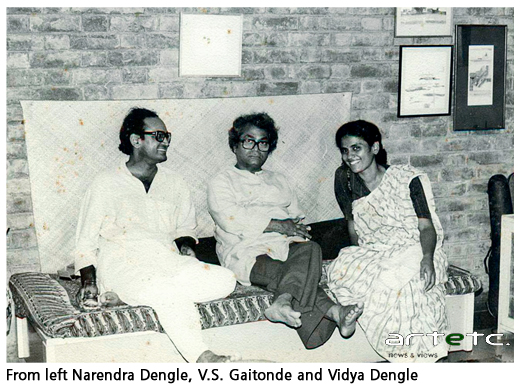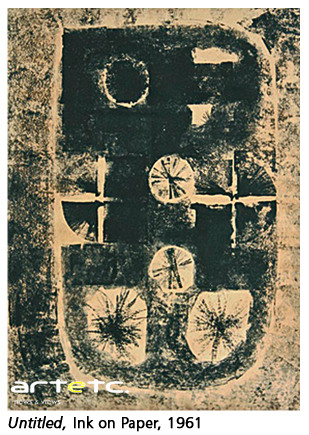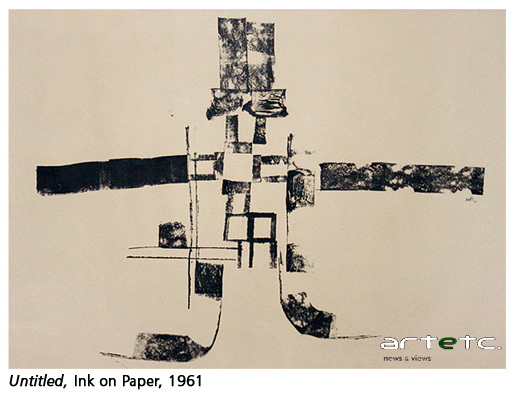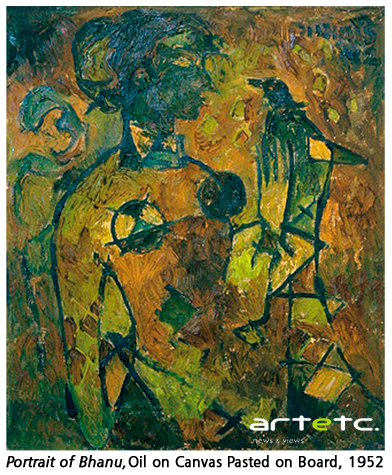- Publisher's Note
- Editorial
- The Enigma That was Souza
- Progressive Art Group Show: The Moderns
- The Souza Magic
- M.F. Husain: Other Identities
- From All, One; And From One, All
- Tyeb Mehta
- Akbar Padamsee: The Shastra of Art
- Sensuous Preoccupations of V.S. Gaitonde
- Manishi Dey: The Elusive Bohemian
- Krishen Khanna: The Fauvist Progressive
- Ram Kumar: Artistic Intensity of an Ascetic
- The Unspoken Histories and Fragment: Bal Chhabda
- P. A. G. and the Role of the Critics
- Group 1890: An Antidote for the Progressives?
- The Subversive Modernist: K.K.Hebbar
- Challenging Conventional Perceptions of African Art
- 40 Striking Indian Sculptures at Peabody Essex Museum
- Tibetan Narrative Paintings at Rubin Museum
- Two New Galleries for the Art of Asia opens at the Museum of Fine Arts in Boston
- Raphael, Botticelli and Titian at the National Gallery of Australia
- The Economics of Patronization
- And Then There Was Zhang and Qi
- What Happened and What's Forthcoming
- Random Strokes
- Yinka Shonibare: Lavishly Clothing the Somber History
- A Majestic “Africa”: El Anatsui's Wall Hangings
- The Idea of Art, Participation and Change in Pistoletto’s Work
- On Wings of Sculpted Fantasies
- The Odysseus Journey into Time in the Form of Art
- On Confirming the Aesthetic of Spectacle: Vidya Kamat at the Guild Mumbai
- Dhiraj Choudhury: Artist in Platinum Mode
- Emerging from the Womb of Consciousness
- Gary Hume - The Indifferent Owl at the White Cube, London
- Daum Nancy: A Brief History
- Experimenting with New Spatial Concepts – The Serpentine Gallery Pavilion Project
- A Rare Joie De Vivre!
- Art Events Kolkata-December 2011– January 2012
- Art Bengaluru
- Mumbai Art Sighting
- Delhi Dias
- Musings from Chennai
- Preview, February, 2012- March, 2012
- In the News-January 2012
ART news & views
Sensuous Preoccupations of V.S. Gaitonde
Issue No: 25 Month: 2 Year: 2012
by Nanak Ganguly

 Broadly, the negotiated space of national/international, in a subliminal manner brought two kinds of subject positions in the Indian art world. First the confrontational and the heroic- outsider to the mainstream and its institutions who upheld a subversive revolutionary identity, and the second that verge on the solipsistic guise, whose reclusive symptoms manifest often through a disquieting expressionism by using the premises of abstractionist formalism. Jacques Derrida called the yearning for disembodied knowledge within Western thought its “heliotropism”- its turn towards the sun in its eagerness for a bright and universal truth, metaphysics pretends that it can do without metaphor, rhetoric, myth, without all the imperfect poetical colouring that animates ordinary language. According to Derrida, the white European replaced the ancient truths of storytelling and poetic transfiguration with pale and bloodless abstract philosophy-that's western minimalism but what about us?
Broadly, the negotiated space of national/international, in a subliminal manner brought two kinds of subject positions in the Indian art world. First the confrontational and the heroic- outsider to the mainstream and its institutions who upheld a subversive revolutionary identity, and the second that verge on the solipsistic guise, whose reclusive symptoms manifest often through a disquieting expressionism by using the premises of abstractionist formalism. Jacques Derrida called the yearning for disembodied knowledge within Western thought its “heliotropism”- its turn towards the sun in its eagerness for a bright and universal truth, metaphysics pretends that it can do without metaphor, rhetoric, myth, without all the imperfect poetical colouring that animates ordinary language. According to Derrida, the white European replaced the ancient truths of storytelling and poetic transfiguration with pale and bloodless abstract philosophy-that's western minimalism but what about us?
 One of the distinguished members of Progressive Artists Group (PAG) formed in the year India gained Independence was an artists who lived in small congested spaces and traveled long distances to meet at Chetana restaurant or the Bombay Art Society or by the sea at Marine Drive and at Rampart Row. “The real common denominator for us was significant form. We were expressing ourselves differently, we had different visions during the early days but what was common was a search for significant. Each in his own way, according to his own vision”- (S.H. Raza). In V. S. Gaitonde's (1924 - 2001) work, was that of a strong abstractionist. He transformed early landscape painting into works of great lyrical transcendence according to Yashodhara Dalmia in her essay on the Group PAG for the show at NGMA in 1996 that marked the opening of its Bombay chapter. Tyeb Mehta, noted, “There was something about Gaitonde's work- of course he was very much influenced by Klee- it was very imaginative and poetic. He did figurative work earlier but soon turned to abstraction. He was very close to Palsikar and Mohan Samant- technically, not image wise. They created their own colour by rubbing cowrie shell on colour into another and create unbelievable texture and colour nuances. This was a technique developed by Palsikar”. Gaitonde's colour surfaces are translucent creating almost an underwater ambience with beams of light penetrating the depths. Even the red of his work gets transmuted into light leading to an almost spiritual sublimation. The linear elements run back and forth between these two masses, and occasionally establish distant satellite areas at the end of their sweep. Despite his direct address and immediacy of marking however Gaitonde's work creates a meditative, and sometimes luscious, atmospheric depth that draws the viewer in. Here, accumulating, linear density is reminiscent of the anxious scrawls that seem to be both forming and yet so tormenting and eating away the drawings churn with the rain, stream and speed whose forms are emerging and dissolving in mist and light and dynamism that constitute an internal landscape. The search is spontaneous and a bodying forth of feeling delivering the pleasures of traditional gestural abstraction in a personal or expressive idiom, which is particularly his genius. The vernacular alphabets, the thin lines not too long and calculated to record any single, sweeping movement of the artist's arm, replace spontaneity with the conscious manipulation of its evidence.
One of the distinguished members of Progressive Artists Group (PAG) formed in the year India gained Independence was an artists who lived in small congested spaces and traveled long distances to meet at Chetana restaurant or the Bombay Art Society or by the sea at Marine Drive and at Rampart Row. “The real common denominator for us was significant form. We were expressing ourselves differently, we had different visions during the early days but what was common was a search for significant. Each in his own way, according to his own vision”- (S.H. Raza). In V. S. Gaitonde's (1924 - 2001) work, was that of a strong abstractionist. He transformed early landscape painting into works of great lyrical transcendence according to Yashodhara Dalmia in her essay on the Group PAG for the show at NGMA in 1996 that marked the opening of its Bombay chapter. Tyeb Mehta, noted, “There was something about Gaitonde's work- of course he was very much influenced by Klee- it was very imaginative and poetic. He did figurative work earlier but soon turned to abstraction. He was very close to Palsikar and Mohan Samant- technically, not image wise. They created their own colour by rubbing cowrie shell on colour into another and create unbelievable texture and colour nuances. This was a technique developed by Palsikar”. Gaitonde's colour surfaces are translucent creating almost an underwater ambience with beams of light penetrating the depths. Even the red of his work gets transmuted into light leading to an almost spiritual sublimation. The linear elements run back and forth between these two masses, and occasionally establish distant satellite areas at the end of their sweep. Despite his direct address and immediacy of marking however Gaitonde's work creates a meditative, and sometimes luscious, atmospheric depth that draws the viewer in. Here, accumulating, linear density is reminiscent of the anxious scrawls that seem to be both forming and yet so tormenting and eating away the drawings churn with the rain, stream and speed whose forms are emerging and dissolving in mist and light and dynamism that constitute an internal landscape. The search is spontaneous and a bodying forth of feeling delivering the pleasures of traditional gestural abstraction in a personal or expressive idiom, which is particularly his genius. The vernacular alphabets, the thin lines not too long and calculated to record any single, sweeping movement of the artist's arm, replace spontaneity with the conscious manipulation of its evidence.
.jpg) The canvases done in earlier years show a move back towards the irisicidence but with newer and stronger symbols filling the space; they seem to suggest an earlier preoccupation with his fundamentally elegiac temperament. It becomes interesting at this point how his small works, the abstraction fights for its life, seeking instead to hold on to that tenuous thread that connects its operations to those of the world, whose appearances, at least are conspicuously absent from their frames. The small vessels seek to break out of “the purified domain of light and colour” that he establishes. He introduces a measure of those “unresolved complexities of ongoing life”. In any event, he brought in a greater number of variables and established a different take on getting back to basics. It is a metaphoric mode of self-presentation: self understood as quasi self, for it has no perceptual components. The presence of the wall is sheer because the perceptual components are woven into the surface: what we are exposed to is the phenomena of sheer surface in which is included the neutral white surface space of the canvas inasmuch as it is part of the woven layers of colour tonalities.
The canvases done in earlier years show a move back towards the irisicidence but with newer and stronger symbols filling the space; they seem to suggest an earlier preoccupation with his fundamentally elegiac temperament. It becomes interesting at this point how his small works, the abstraction fights for its life, seeking instead to hold on to that tenuous thread that connects its operations to those of the world, whose appearances, at least are conspicuously absent from their frames. The small vessels seek to break out of “the purified domain of light and colour” that he establishes. He introduces a measure of those “unresolved complexities of ongoing life”. In any event, he brought in a greater number of variables and established a different take on getting back to basics. It is a metaphoric mode of self-presentation: self understood as quasi self, for it has no perceptual components. The presence of the wall is sheer because the perceptual components are woven into the surface: what we are exposed to is the phenomena of sheer surface in which is included the neutral white surface space of the canvas inasmuch as it is part of the woven layers of colour tonalities.
When his painting is not before us the recall sensations stay with us; the interaction between repetition and recollection has already become a part of the memory. What stays in the memory is not so much the repetitive nature of the surface but the sensations one had of it. “My entire outlook changed when I came to know that the Chinese have no epics to boast of for the single reason that an epic covers a long period of time and its basically wrong to say, for instance that any age can be heroic. Any abstract feeling can be valid for a single moment. On is not in love eternally, even if the feeling is there. The ecstasy of the moment cannot be stretched over a long period“- (in conversation with S.G.Vasudev). Such a painting represents an immense shift in our sensibility; the intensities of the sensation are more acute while gripping our psyches, engaging our bodies and filling our minds. The images here are replete with images retrieved from the times and spaces he has navigated inwardly and intensely with an indiscriminate abandon and unconfined. So do the measures taken to retard, decay and fend off damage; his abstraction implores us to look at the rest of painting as if it were abstract.
 He was born in 1924 in Nagpur and graduated from the Sir J. J. School of Art in 1948, and was subsequently asked to join the Progressive Artists Group. In his work is never anything more than a refinement or a mannered distortion of components of pigment, totally consistent with previous history of painting, and capable of very many of its effects, though the metaphor of illumination is basic to his language. The compulsiveness of the little gesture out of which they are made lends them a private, even hermetic character, where he repeatedly proclaims the neutrality and emptiness. His rarely seen drawings, paintings and photographs with unique archival material from his studio in Nizamuddin, and provide the occasion to further position his practice both within the history of Indian art and in relation to an international avant-garde. Within the relatively quiet frame there is intense activity; obviously, the energy made visible is controlled, and one has to watch closely the expressive visual modulation of colour into which are woven interlocking planes, which are so thin that they may go unnoticed.
He was born in 1924 in Nagpur and graduated from the Sir J. J. School of Art in 1948, and was subsequently asked to join the Progressive Artists Group. In his work is never anything more than a refinement or a mannered distortion of components of pigment, totally consistent with previous history of painting, and capable of very many of its effects, though the metaphor of illumination is basic to his language. The compulsiveness of the little gesture out of which they are made lends them a private, even hermetic character, where he repeatedly proclaims the neutrality and emptiness. His rarely seen drawings, paintings and photographs with unique archival material from his studio in Nizamuddin, and provide the occasion to further position his practice both within the history of Indian art and in relation to an international avant-garde. Within the relatively quiet frame there is intense activity; obviously, the energy made visible is controlled, and one has to watch closely the expressive visual modulation of colour into which are woven interlocking planes, which are so thin that they may go unnoticed.
How does one treat or look at the disparate genre that is produced. Treats, that is to say transforms, exchanges, trades negotiates, leaves nothing of the pre-established classifications intact and play all the meanings- gender, sexual, grammatical and visual. Now the novelty of the work discussed here born precisely of this articulation which considers together, and the triple practice conjugating questions of various orders, a treat to watch in this perspective gives a specific turn to the problematic in so far as it is indissociable from those beyond art. The images or the visual texts that mediate through our own experience we jealously guard and with skills we guard our symptoms. They are something we wish to give for they speak our desire. But the same desire may find other forms of representation and interrogates painterly values at the same time. The beauty and idea of works such as his hold us in extreme promises to challenge representation as “formidable tool of domination” but to a redefinition of a visual text because its high time to realize we will no more be restricted by debased modernism and redefine the definition, of realism, abstraction and cultural representation.